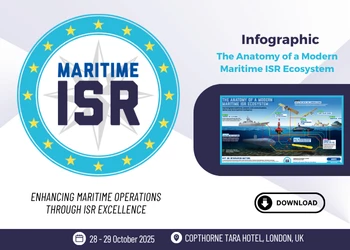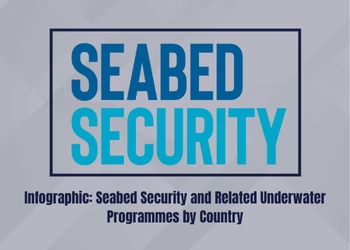Cross-Sector Innovation: A Pathway to UK Defence Transformation
Add bookmark
The UK Defence Solutions Centre (UKDSC) launched a new Cross-Sector Innovation challenge in January 2020, 'Subsea Autonomous Systems: Next Generation Technologies'. I spoke with David Wotherspoon, Executive Director - Innovation, UKDSC and Head of Maritime Innovation, Chris Shepherd, to find out more about the project.
In his 2004 book, ‘Open Innovation: The New Imperative for Creating and Profiting from Technology’, Henry Chesborough, organizational theorist and adjunct professor at Berkeley University, argued that commercial enterprise needed “a new logic of innovation” to succeed in “the networked world”.
This new logic, what Chesborough described as ‘Open Innovation’, would engender an enterprise-wide mind-set shift to “leverage this distributed landscape of knowledge, instead of ignoring it in the pursuit of their own internal research agendas” and, instead of “hoarding technology for your own use,” he wrote, “you make money by leveraging multiple paths to market for your technology”.
- Find out more about Defence iQ's annual Disruptive Technology for Defence Transformation conference taking place in September 2020
Although Chesborough wasn’t writing about ‘Open Innovation’ in the context of Defence, his ideas for ‘innovating innovation’ seem, certainly in the UK Defence community, to be of particular relevance 16 years later, and provide a useful framework for thinking about how the UK MOD and, specifically, the Royal Navy, are approaching technological development and exploitation today.
From Open to Cross-Sector Innovation
Similar to Chesborough’s concept, UK Defence is starting to embrace Cross-Sector Innovation (CSI), which ties into the wider UK MOD innovation strategy for increasing public-private sector collaboration and HMG’s international export priorities. Like Open Innovation, CSI enables the alignment and exploitation of knowledge between Defence and other sectors, bringing about opportunities for the co-development and co-application of new technologies via a working model that is both collaborative and competitive.
The chief champion of CSI is the UK Defence Solutions Centre, the independent body set up in 2015 that sits in the “neutral space between industry and the military”, as David Wotherspoon, Executive Director - Innovation UKDSC, describes it, working with both sides to “interrogate and support their needs and aspirations”.
In their unique position inside the UK’s innovation ecosystem, the UKDSC has one key priority: to expand the UK’s defence supply chain by engendering “exploitation pathways”, David explained, so that technology isn’t simply developed for innovation’s sake but, rather, with the early and deliberate intent to commercialise it and, crucially, find applications and share costs across multiple sectors. Enter their Cross-Sector Innovation initiatives that “are about piloting methods by which Defence can build up a portfolio of trust with industry and develop small pilot projects that allow for technology development”.
Subsea Autonomous Systems: Fertile Ground for Cross-Sector Innovation
The first of these CSI pilot projects is Subsea Autonomous Systems: Next Generation Technologies, which has brought together a broad church of industry and government bodies including the MOD, Royal Navy, DASA, UKRI-Innovate UK, SUBSEA UK, NSRI, BP, OGTC, OGA and the Offshore Energy Sector. The project will “address specific opportunities to deliver joint benefit to both the Defence and Offshore sectors by developing, jointly through their supply chains, a range of innovative emerging and enabling technology solutions” (see the UKDSC Press Release for more information here).
Off the back of this, £6.1 million worth of funding has been made available to initiate an innovation competition. The competition will see participants from the traditional and non-traditional defence sectors, the Offshore Energy sector, SMEs and academia collaborate on business-led ideation to develop subsea autonomous technologies for the Royal Navy and Offshore Energy sector that are modular in design with common interfaces and open architectures. There are four technology areas: Power & Communications, Sensors, Detection, Navigation, Processing and Data Fusion, Deployment and Modularity and Operations.
When asked why UKDSC’s CSI initiative was starting with subsea technology, David and Head of Maritime Innovation, Chris Shepherd, explained that there was clear and obvious opportunity for “sector alignment” between Defence and the Offshore Energy sector. Both operate in “high risk environments”; have “similar safety needs, operations and technologies” and “rely on the supply chain for support and maintenance”. Regarding autonomous systems, they added, both face the same challenges with building “the complete trust package around those vehicles” in such a high-risk environment.
Leveraging the Knowledge Landscape: The CSI The Innovation Lab
Upon identifying the cross-sector opportunity and outlining the outcomes they wanted to achieve, the Subsea Autonomous Systems: Next Generation Technologies competition opened in January 2020 and, following industry briefings and the application process, there will be a 5-day collaborative residential workshop known as the Innovation Lab taking place in April (read the full competition brief here).
This is where we see ‘innovating innovation’ and the leveraging of knowledge, as Chesborough described it, in practice. Workshop participants, who are screened via psychometric evaluations before accepted to participate, are expected to work together to develop “research and innovation projects that deliver concept demonstrators”.
The point of this, explained David and Chris, is to “bring together groups of people that have technologies that span that TRL [Technology Readiness Level] stack” and “create collaborations around a problem that’s not well-defined yet”. The workshop will also feature mentors, facilitators and artists to help articulate some of the complex ideas put forward.
The psychological assessments, “an important piece” of the Innovation Lab, also enables the project leads to be more selective about who joins the competition, bearing in mind that over the five days participants will need to collaborate (and compete) with each other to help shape the organic development of technology proposals. Beyond technical expertise, participants presumably will require particular social skills to help them work as part of a collaborative problem-solving unit (see A Framework for Teachable Collaborative Problem Solving Skills for some ideas on collaborative learning behaviours). Helpfully, too, applicants receive feedback on their ‘scores’ at the end of the process.
A Pathway to UK Defence Transformation
Rounding up our interview at their competition briefing in Glasgow, I asked David and Chris to talk me through what success looks like and future plans to expand CSI into other domains or technologies. Simply put, they explained, the best outcome is to “start developing new technologies, combining them to create future capabilities with a view to exporting them overseas, and therefore further supporting the UK prosperity agenda”. “Over and above that,” they added, the goal is to start “building those sustainable relationships between Offshore Energy and Defence”. Other pilots, too, are currently in development.
Innovation starts with a change of mind-set, and it was acknowledged at the event that often dual-use or cross-sector technology applications involving Defence “happen by chance, not from the ground up”. This new emphasis on Cross-Sector Innovation marks a new and exciting journey for the Royal Navy and UK Defence – a credible, deliberate “exploitation pathway”.























